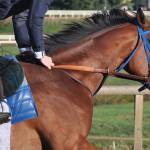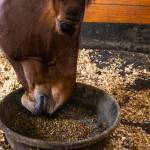Training and Bone Development

The main role of the equine skeleton is to provide structural support. In addition to bones, the skeletal system also includes tendons, ligaments, and cartilage. Each element of the musculoskeletal system must be functioning correctly in order for the horse to travel soundly. Bones must oppose muscular contraction to create movement and withstand the forces of the applied loads resulting from the horse’s weight, speed, and interactive forces with racetrack surfaces.
The bones of the skeleton determine structural correctness and balance. A horse’s conformation determines how efficiently the horse moves. Thus the relationships of alignment, length, and angle of the bones of the skeleton have tremendous effects on athletic ability and long-term soundness of horses. A horse galloping at race speed will place three times its body weight in force on the lower limb.
There is a complicated support system for the skeleton, as muscles, tendons, ligaments, cartilage, joint lubricants, and hoof structures help dissipate the forces of locomotion. Ultimately, however, the strength of the bones of the legs must bear the loads created by exercise and training. Acute malfunction of the skeletal system is most often related to the amount of bone mineral found in the cannon bone.
Strength of bone is derived from a mineralized cartilage framework. Bone is a dynamic tissue and is therefore responsive to forces placed upon it. Bone also responds to changes in the amounts and ratios of calcium, phosphorus, and magnesium in the horse’s diet. In addition, copper, zinc manganese, vitamins A and D and other nutrients have significant effects on bone development.
If the horse is fed a well-balanced and well-fortified diet, then the largest single factor affecting bone strength is exercise. The remodeling of bone in response to exercise involves removing bone cells via osteoclasts (cells that destroy bone so that it can be replaced with stronger bone) and then building bone by osteoblasts (cells that make the cartilage matrix and are eventually mineralized).
One theory of bone remodeling is that osteoclastic precursors recognize a change in the mechanical properties of bone, which signals the need for increased structural strength of new bone. While the exact signal for remodeling is unknown, the effective signal is strain. Strains result from deformation of an object by a force. The faster the horse runs, the higher the amount of strain on bones. Getting enough strain to signal an increase in bone development while not straining the bone to the point of fracture is a difficult balancing act.
Recent research supports the idea that bone shape and mechanical and chemical properties can be affected by exercise or lack thereof from birth throughout the life of the horse. Research from the Netherlands reported significantly lower (37% ± 4%) bone density of the third tarsal bone of the hock of five-month-old foals that were housed in box stalls compared to pasture-raised and box-raised foals that were sprint-trained from one day of age. However, the authors caution against the sprint training of foals because of possible negative long-term effects. In another study from Michigan State University, researchers maintained 17 weanling Arabian horses in stalls 24 hours/day, on pasture 12 hours/day, or on pasture 24 hours/day for 56 days. Nutrient intakes were standardized.
The 12-hour pasture turnout group and the full-time pasture turnout group had increased bone mineral contents. Cannon bone circumference increased in both the pasture group and the 12-hour pasture groups, but not in the stalled group. The take-home message is to try to keep foals, weanlings and yearlings turned out at least 12 hours a day.
At a recent Equine Science Symposium, researchers from Kentucky Equine Research presented the findings of a study on skeletal adaptations with the onset of training in Thoroughbreds. The researchers reported that when yearlings leave the breeding farm and enter training, major changes occur in their skeletons. Much of this change is due to alterations in housing and exercise. However, nutrition may also play a role. Bone density, size and shape were tracked in fifteen Thoroughbred yearlings as they entered race training.
Monthly radiographs of the cannon bone were taken using a reference standard. Bone mineral content (BMC) was calculated, and plasma concentrations of calcium, phosphorus, and osteocalcin (a hormone signaling bone growth) were also measured monthly. The yearlings entered training (day 0) in late November on a Kentucky farm. Horses were confined in stalls for approximately 6 hours per day. The training intensity at this time was low, consisting of 15-20 minutes per day jogging in a paddock.
In late December (day 28) the horses were moved to a Kentucky training center where little or no turnout was available. For the remainder of the study the horses were confined in stalls for approximately 23 hours per day. In January and February (day 28- 84) the horses (now two years old) were lightly exercised in an indoor arena. Training intensity increased in March (day 84-112) after which horses were kept at an intense level of training.
Bone mineral content of the cannon bone dropped from the day the horses went to the training center, day 28, until day 84. During this time the horses were confined to stalls with only light exercise. Weather conditions improved, the horses were moved out to the training track, and training intensity increased. The results revealed that as exercise intensity increased, BMC of the cannon bone increased to levels that the horses had prior to being confined and lightly exercised. Plasma osteocalcin levels dropped slightly from day 0-84 when the horses were confined and in light training. Levels increased from day 84-112 when the horses began intense exercise, suggesting an increase in bone formation. Plasma calcium also dropped significantly from day 28 to 84. There was a large increase in plasma calcium levels when training intensity increased. Plasma phosphorus followed a similar pattern of change with exercise.
These results, along with previously published information, begin to emphasize the importance of exercise to bone strength. Confinement of greater than approximately 12 hours may result in decreased BMC, and jogging and easy galloping will not “turn on” or signal the bone-building mechanism. Horses in training require speed work introduced early. It probably does not take more than breezing just under a 1/8 of a mile to signal bone formation. While lots of jogging and slow galloping may help with a horse’s cardiovascular fitness, this program is not going to strengthen bone sufficiently to meet the rigors of racing.
Early speed for short bursts is also thought to help avoid “bucked shins.” David Nunamaker, VMD of the Universityof Pennsylvania’s New Bolton Center has data that suggest breezing 1/8 of a mile in 14 seconds will increase bone mineral content and also remodel the bone so that it can handle the forces associated with racing.
He suggested that galloping almost 2.5 miles a day at a speed of 1/8 mile in 18 seconds does not signal the bone to strengthen, and the repetitive slow galloping is actually counter-productive because it can lead to stress fractures and eventually “bucked shins.” Nunamaker suggested that as horses begin to train and get fit, trainers should begin breezing the horses two or three times a week for short bursts of not more than 1/8 mile at first. He also suggested cutting back on the number of days trainers gallop horses for two miles.
While there is some information on exercise and bone development from which to make inferences, a definitive answer has not yet been found as to the perfect amount of exercise to support optimal bone development.








